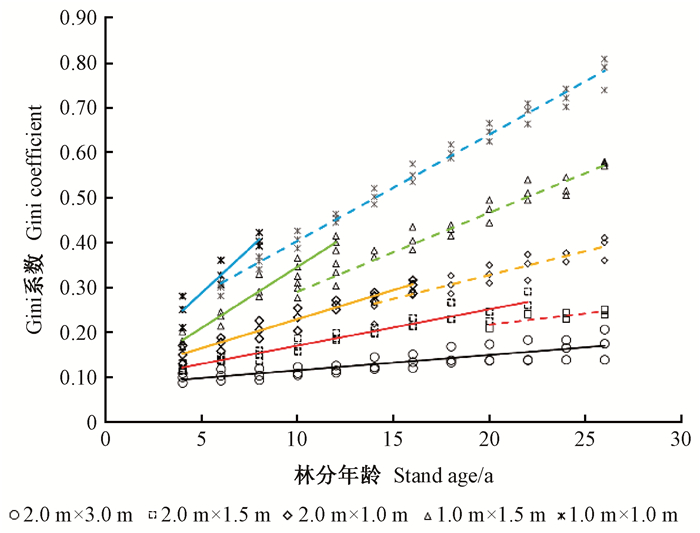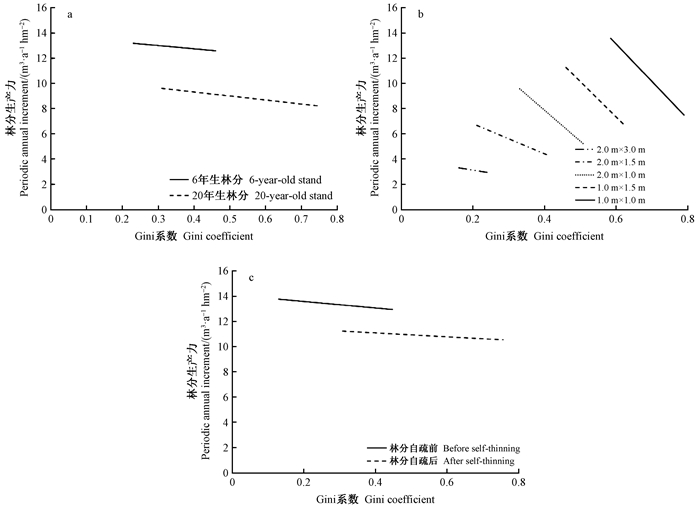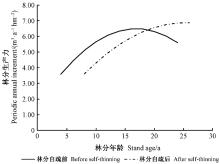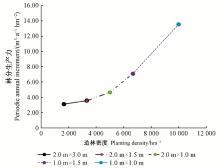

Scientia Silvae Sinicae ›› 2019, Vol. 55 ›› Issue (11): 126-136.doi: 10.11707/j.1001-7488.20191114
Previous Articles Next Articles
Guijuan Yang1,Haifan Hu2,Honggang Sun2,*,Jianguo Zhang1,Aiguo Duan1
Received:2019-03-25
Online:2019-11-25
Published:2019-12-21
Contact:
Honggang Sun
Supported by:CLC Number:
Guijuan Yang,Haifan Hu,Honggang Sun,Jianguo Zhang,Aiguo Duan. The Influences of Stand Age, Planting Density and Self-Thinning on Relationship between Size Inequality and Periodic Annual Increment in Chinese Fir (Cunninghamia lanceolata)Plantations[J]. Scientia Silvae Sinicae, 2019, 55(11): 126-136.
Table 1
Descriptive statistics of the experimental plots"
| 样地编号 Plot No. | 造林密度 Planting density/(tree·hm-2) | 2006年活立木株数Survival trees in 2006/(tree·hm-2) | 林分平均胸径 Mean DBH/cm | 胸径范围 DBHmin~DBHmax/cm |
| A1 | 1 667 | 1 364 | 19.07(±2.95) | 3.80~23.70 |
| A2 | 1 667 | 1 484 | 17.41(±2.06) | 10.20~24.10 |
| A3 | 1 667 | 1 439 | 19.28(±2.14) | 9.70~31.50 |
| B1 | 3 333 | 2 653 | 15.31(±2.58) | 7.90~25.70 |
| B2 | 3 333 | 2 938 | 10.65(±2.42) | 6.49~13.80 |
| B3 | 3 333 | 1 754 | 12.29(±2.71) | 7.58~16.23 |
| C1 | 5 000 | 3 868 | 12.82(±2.54) | 3.80~23.74 |
| C2 | 5 000 | 3 598 | 9.57(±2.44) | 5.51~13.16 |
| C3 | 5 000 | 2 743 | 10.21(±2.74) | 6.04~14.04 |
| D1 | 6 667 | 4 647 | 8.76(±2.02) | 5.53~11.90 |
| D2 | 6 667 | 4 212 | 8.85(±2.67) | 4.95~13.14 |
| D3 | 6 667 | 2 983 | 9.13(±2.62) | 5.33~13.26 |
| E1 | 10 000 | 4 152 | 8.39(±2.01) | 5.55~11.70 |
| E2 | 10 000 | 3 328 | 8.42(±2.50) | 4.80~13.08 |
| E3 | 10 000 | 1 484 | 8.75(±2.71) | 5.10~13.11 |

Fig.2
Relationship between stand age and Gini coefficient at the five planting densities in Chinese fir plantations Solid lines indicate linear relationship between stand age and Gini coefficient before self-thinning happened and dished lines represent relationship between stand age and Gini coefficient after self-thinning happened. "

Table 2
Parameter estimates for the Gini coefficient using the generalized linear mixed effect models based on the effect on stand age, planting density and self-thinning"
| 固定效应项 Fixed components | 模型Models | ||
| Gini(Age) | Gini(Den) | Gini(Mort) | |
| 截距项Intercept | 0.370 4(< 0.000 1) | 0.293 6(< 0.000 1) | 0.355 9(< 0.000 1) |
| A | 0.251 4(0.002 84) | NA | 0.127 5(< 0.000 1) |
| Mort | -0.079 2(0.001 68) | -0.016 8(0.003 66) | -0.183 2(0.000 73) |
| Den2.0 m×1.5 m | 0.063 3(0.000 50) | 0.193 7(0.004 74) | NA |
| Den2.0 m×1.0 m | 0.071 6(< 0.000 1) | 0.256 4(0.002 65) | NA |
| Den1.0 m×1.5 m | 0.086 3(< 0.000 1) | 0.390 8(0.001 63) | NA |
| Den1.0 m×1.0 m | 0.094 5(< 0.000 1) | 0.446 3(0.003 20) | NA |
| A ×Mort | 0.015 5(0.004 62) | NA | 0.058 3(0.001 82) |
| A × Den2.0 m×1.5 m | 0.033 2(0.004 39) | NA | NA |
| A × Den2.0 m×1.0 m | 0.039 4(0.003 23) | NA | NA |
| A × Den1.0 m×1.5 m | 0.041 7(0.001 85) | NA | NA |
| A × Den1.0 m×1.0 m | 0.048 6(0.004 73) | NA | NA |
| Mort × Den2.0 m×1.5 m | 0.024 6(0.004 72) | -0.064 4(< 0.000 1) | NA |
| Mort × Den2.0 m×1.0 m | 0.037 9(0.003 20) | -0.057 0(< 0.000 1) | NA |
| Mort × Den1.0 m×1.5 m | 0.039 5(0.002 56) | -0.038 2(< 0.000 1) | NA |
| Mort × Den1.0 m×1.0 m | 0.042 8(0.003 41) | -0.031 9(< 0.000 1) | NA |
| R2 | 0.986 | 0.972 | 0.953 |
| RMSE | 0.141 | 0.161 | 0.117 |
| r | 0.872 | 0.853 | 0.944 |
Table 3
Parameter estimates for PAI using the generalized linear mixed effect models"
| 固定效应项 Fixed components | 模型Models | ||
| PAI(Age) | PAI(Den) | PAI(Mort) | |
| 截距项Intercept | 7.247 2(0.004 9) | 3.845 5(< 0.000 1) | 2.682 1(0.041 6) |
| A | 0.782 4(0.018 7) | NA | 0.591 2(0.002 3) |
| A2 | -0.026 9(0.036 2) | NA | -1.548 0(1.244 5) |
| Gini | -1.834 0(0.000 4) | -2.908 5(0.023 7) | -0.691 5(0.048 1) |
| Mort | NA | 5.240 7(0.026 1) | 3.028 4 (0.029 3) |
| Den2.0 m×1.5 m | 1.832 3(0.002 3) | 1.258 6(0.000 5) | NA |
| Den2.0 m×1.0 m | 2.377 5(0.023 7) | 3.642 5(0.008 7) | NA |
| Den1.0 m×1.5 m | 4.860 3(0.034 4) | 4.981 2(0.004 4) | NA |
| Den1.0 m×1.0 m | 5.494 2(0.002 7) | 5.739 4(0.025 9) | NA |
| A×Gini | NA | NA | -4.961 7(0.006 1) |
| A× Mort | -0.234 9(0.016 3) | NA | -0.741 6(< 0.000 1) |
| A× Den2.0 m×1.5 m | NA | NA | 1.684 2(0.561 8) |
| A× Den2.0 m×1.0 m | NA | NA | 2.183 3(0.337 1) |
| A× Den1.0 m×1.5 m | NA | NA | 2.835 4(1.546 2) |
| A× Den1.0 m×1.0 m | NA | NA | 3.665 9(1.721 8) |
| A2× Gini | -0.025 1(0.384 5) | NA | NA |
| A2× Mort | NA | NA | 0.384 6(< 0.000 1) |
| Gini× Mort | NA | -2.452 8(0.010 9) | -0.174 3(0.167 1) |
| Mort× Den2.0 m×1.5 m | NA | 2.617 3(0.002 2) | NA |
| Mort× Den2.0 m×1.0 m | NA | 5.781 8(0.039 1) | NA |
| Mort× Den1.0 m×1.5 m | NA | 8.653 9(0.037 4) | NA |
| Mort× Den1.0 m×1.0 m | NA | 11.274 4(0.002 5) | NA |
| Gini × Den2.0 m×1.5 m | NA | -3.738 2(0.043 8) | -0.378 1(0.008 1) |
| Gini × Den2.0 m×1.0 m | NA | -5.698 0(0.003 1) | -1.559 7(0.001 6) |
| Gini × Den1.0 m×1.5 m | NA | -9.403 8(0.042 6) | -2.670 4(0.002 5) |
| Gini × Den1.0 m×1.0 m | NA | -12.817 3(0.020 7) | -3.418 3(0.005 9) |
| R2 | 0.938 1 | 0.891 7 | 0.912 5 |
| RMSE | 0.164 3 | 0.276 1 | 0.175 0 |
| r | 0.891 7 | 0.858 6 | 0.914 3 |

Fig.5
The effect of size inequality on PAI at stand age, planting density and self-thinning of Chinese fir plantations The trend lines in the Fig. 5a-c were deduced as the following steps. Firstly, the fixed components of the model(5), (6) and(7)were deleted based on the NA in the Tab. 3. Secondly, the first derivative models of the PAI versus Gini were computed and the estimated parameters were added in the first derivative model. Finally, the trend lines of PAI with stand age, planting density and self-thinning were drawn in the different stand age, planting density and before and after self-thinning conditions. "


Fig.6
The dynamic of PAI of the Chinese fir plantations before and after self-thinning trajectory The trend line of PAI(Mort) versus age(A)before self-thinning trajectory was deduced as the following steps. Firstly, the values with Mort=0, the upper Gini limit 0.4 and the estimated parameters of the PAI(Mort)in the Tab. 3 were added the model(7), and then the trend line between PAI(Mort)and A was drawn before self-thinning began between 4 and 24 stand age. The trend line of PAI(Mort) versus age(A) after self-thinning trajectory was deduced as the following steps.Firstly, the values with Mort=1, the upper Gini limit 0.8 and the estimated parameters of the PAI(Mort) in the Tab. 3 were added the model (7).and then the trend line between PAI(Mort) and A was drawn after self-thinning began between 6 and 26 stand age. "


Fig.7
The dynamic of PAI of Chinese fir plantations at the different planting densities The PAI versus planting density was deduced as the following steps. Firstly, the values with Mort=0, the upper Gini limit 0.4 and the estimated parameters of the PAI(Den)in the Tab. 3 were added the model (6) and then the PAI was computed before self-thinning happened at the different planting density. Thirdly, the values with Mort=1, the upper Gini limit 0.8 and the estimated parameters of the PAI(Den)in the Tab. 3 were added the model(6) and then the PAI was computed after self-thinning happened at the different planting density. Finally, the total PAI was summed PAI before and after self-thinning happened at the different planting density. "

| 丁贵杰, 周正贤, 严仁发, 等. 造林密度对杉木生长进程及经济效果影响的研究. 林业科学, 1997. 33 (专1): 67- 75. | |
| Ding G J , Zhou Z X , Yan R F , et al. Influence of planting density on growth process and economic effect of Chinese fir plantations. Scientia Silvae Sinicae, 1997. 33 (Sp.1): 67- 75. | |
| 方匡南, 朱建平, 姜叶飞. R数据分析方法与案例详解. 北京: 电子工业出版社. 2015. | |
| Fang K N , Zhu J P , Jiang Y F . R data analysis:methods and application. Beijing: Publishing House of Electronics Industry. 2015. | |
|
方奇. 从生产力资源利用和养分循环综合评价杉松混交组合. 林业科学, 1997. 33 (6): 513- 527.
doi: 10.3321/j.issn:1001-7488.1997.06.005 |
|
|
Fang Q . A comprehensive evaluation of mixed plantations of Chinese fir and Pines based on productivity, resource-use and nutrient cycling. Scientia Silvae Sinicae, 1997. 33 (6): 513- 527.
doi: 10.3321/j.issn:1001-7488.1997.06.005 |
|
| 方奇. 不同密度杉木幼林系统生产力和生态效益研究. 林业科学, 2000. 36 (专1): 28- 35. | |
| Fang Q . Study on productivity and ecological benefits of young growth Chinese fir plantations systems in different densities. Scientia Silvae Sinicae, 2000. 36 (Sp.1): 28- 35. | |
| 何宗明, 杨玉盛, 邱仁辉, 等. 栽杉留阔模式的杉木生长过程特点. 林业科学, 2000. 36 (专1): 143- 147. | |
| He Z M , Yang Y S , Qiu R H , et al. Study on growth process characteristics of Chinese fir under the patterns of reserving broad leaved trees in Chinese fir plantation. Scientia Silvae Sinicae, 2000. 36 (Sp.1): 143- 147. | |
| 惠刚盈, 罗云伍, 张校林. 江西大岗山丘陵区杉木人工林生产力的研究. 林业科学, 1989. 25 (6): 584- 589. | |
| Hui G Y , Luo Y W , Zhang X L . A study on the productivity of common Chinese fir(Cunninghamia lanceolata)plantation at hilly area in Dagang Mountain, Jiangxi Province. Scientia Silvae Sinicae, 1989. 25 (6): 584- 589. | |
| 刘景芳, 童书振. 编制杉木林分密度管理图研究报告. 林业科学, 1980. 16 (4): 241- 251. | |
| Liu J F , Tong S Z . Studies on the stand density control diagram for Cunninghamia lanceolata. Scientia Silvae Sinicae, 1980. 16 (4): 241- 251. | |
|
刘世荣, 杨予静, 王晖. 中国人工林经营发展战略与对策:从追求木材产量的单一目标经营转向提升生态系统服务质量和效益的多目标经营. 生态学报, 2018. 38 (1): 1- 10.
doi: 10.3969/j.issn.1673-1182.2018.01.001 |
|
|
Liu S R , Yang Y J , Wang H . Development strategy and management countermeasures of planted forests in China:transforming from timber-centered single objective management towards multi-purpose management for enhancing quality and benefits of ecosystem services. Acta Ecologica Sinca, 2018. 38 (1): 1- 10.
doi: 10.3969/j.issn.1673-1182.2018.01.001 |
|
| 马祥庆, 庄孟能, 叶章善. 杉木拟赤杨混交林林分生产力及生态效应研究. 植物生态学报, 1998. 22 (2): 178- 185. | |
| Ma X Q , Zhuang M N , Ye Z S . Study on the productivity and ecological benefits in mixed forests of Cunninghamia lanceolata and Alniphyllum fortunei. Chinese Journal of Plant Ecology, 1998. 22 (2): 178- 185. | |
|
盛炜彤. 杉木林的密度管理与长期生产力研究. 林业科学, 2001. 37 (5): 2- 9.
doi: 10.3321/j.issn:1001-7488.2001.05.002 |
|
|
Sheng W T . A study on stand density management and long term productive of Chinese fir(Cunninghamia lanceolata) plantation. Scientia Silvae Sinicae, 2001. 37 (5): 2- 9.
doi: 10.3321/j.issn:1001-7488.2001.05.002 |
|
| 唐守正, 李希菲. 同龄纯林自稀疏方程验证. 林业科学, 1995. 31 (1): 27- 34. | |
| Tang S Z , Li X F . Testing for self-thinning equation of even aged pure stands. Scientia Silvae Sinicae, 1995. 31 (1): 27- 34. | |
| 童书振, 张建国, 罗红艳, 等. 杉木林密度间伐试验. 林业科学, 2000. 36 (专1): 86- 89. | |
| Tong S Z , Zhang J G , Luo H Y , et al. Studies on the density and thinning experiments on Chinese fir stands. Scientia Silvae Sinicae, 2000. 36 (Sp.1): 86- 89. | |
| 张水松, 陈长发, 何寿庆, 等. 杉木林间伐强度自然稀疏与结构规律研究. 林业科学, 2006. 42 (1): 55- 62. | |
| Zhang S S , Chen C F , He S Q , et al. The natural thinning and structural pattern of the intermediate cutting intensity in the Cunninghamia lanceolata stand. Scientia Silvae Sinicae, 2006. 42 (1): 55- 62. | |
|
Ali A . Forest stand structure and functioning:current knowledge and future challenges. Ecological Indicators, 2019. 98, 665- 677.
doi: 10.1016/j.ecolind.2018.11.017 |
|
| Binkley D , Kashian D M , Boyden S , et al. Patterns of growth dominance in forests of the Rocky Mountains, USA. Forest Ecology and Management, 2006. 236 (2/3): 193- 201. | |
| Binkley D , Stape J L , Bauerle W L , et al. Explaining growth of individual trees:light interception and efficiency of light use by Eucalyptus at four sites in Brazil. Forest Ecology and Management, 2010. 259 (3): 1704- 1713. | |
|
Bourdier T , Cordonnier T , Kunstler G , et al. Tree size inequality reduces forest productivity:an analysis combining inventory data for ten European species and a light competition model. PloS One, 2016. 11 (3): e0151852.
doi: 10.1371/journal.pone.0151852 |
|
|
Boyden S , Binkley D , Stape J L . Competition among Eucalyptus trees depends on genetic variation and resource supply. Ecology, 2008. 89 (10): 2850- 2859.
doi: 10.1890/07-1733.1 |
|
| Caplat P , Anand M , Bauch C . Symmetric competition causes population oscillations in an individual-based model of forest dynamics. Ecological Modelling, 2008. 211 (3/4): 491- 500. | |
|
Cordonnier T , Kunstler G . The Gini index brings asymmetric competition to light. Perspectives in Plant Ecology, Evolution and Systematics, 2015. 17 (2): 107- 115.
doi: 10.1016/j.ppees.2015.01.001 |
|
|
Damgaard C , Weiner J . Describing inequality in plant size or fecundity. Ecology, 2000. 81 (4): 1139- 1142.
doi: 10.1890/0012-9658(2000)081[1139:DIIPSO]2.0.CO;2 |
|
| Forrester D I, Bauhus J. 2016. A review of processes behind diversity-productivity relationships in forests. Current Forestry Reports, 2(1): 45-61. | |
|
Knox R G , Peet R K , Christensen N L . Population dynamics in loblolly pine stands:changes in skewness and size inequality. Ecology, 1989. 70 (4): 1153- 1167.
doi: 10.2307/1941383 |
|
|
LaBarbera M . Analyzing body size as factor in ecology and evolution. Annual Review of Ecology and Systematics, 1989. 20, 97- 117.
doi: 10.1146/annurev.es.20.110189.000525 |
|
|
Lei X , Wang W , Peng C . Relationships between stand growth and structural diversity in spruce-dominated forests in New Brunswick, Canada. Canadian Journal of Forest Research, 2009. 39 (10): 1835- 1847.
doi: 10.1139/X09-089 |
|
| Lexerød N L , Eid T . An evaluation of different diameter diversity indices based on criteria related to forest management planning. Forest Ecology and Management, 2006. 222 (1/3): 17- 28. | |
|
Lhotka J M . Examining growth relationships in Quercus stands:An application of individual-tree models developed from long-term thinning experiments. Forest Ecology and Management, 2017. 385, 65- 77.
doi: 10.1016/j.foreco.2016.11.029 |
|
|
Liang J , Buongiorno J , Monserud R A , et al. Effects of diversity of tree species and size on forest basal area growth, recruitment, and mortality. Forest Ecology and Management, 2007. 243 (1): 116- 127.
doi: 10.1016/j.foreco.2007.02.028 |
|
|
Lin Y , Berger U , Yue M , et al. Asymmetric facilitation can reduce size inequality in plant populations resulting in delayed density-dependent mortality. Oikos, 2016. 125 (8): 1153- 1161.
doi: 10.1111/oik.02593 |
|
|
Lorenz M O . Methods of measuring the concentration of wealth. Publication of the American Statistical Association, 1905. 9 (70): 209- 219.
doi: 10.2307/2276207 |
|
|
McGown K I , O'Hara K L , Youngblood A . Patterns of size variation over time in ponderosa pine stands established at different initial densities. Canadian Journal of Forest Research, 2016. 46 (1): 101- 113.
doi: 10.1139/cjfr-2015-0096 |
|
|
Petersen J E , Brandt E C , Grossman J J , et al. A controlled experiment to assess relationships between plant diversity, ecosystem function and planting treatment over a nine year period in constructed freshwater wetlands. Ecological Engineering, 2015. 82, 531- 541.
doi: 10.1016/j.ecoleng.2015.05.002 |
|
| Pinheiro J , Bates D , DebRoy S , et al. Nlme:Linear and nonlinear mixed effects models. R Package Version, 2015. 3 (1-121): 121. | |
|
Priego-Santander Á G , Campos M , Bocco G , et al. Relationship between landscape heterogeneity and plant species richness on the Mexican Pacific coast. Applied Geography, 2013. 40, 171- 178.
doi: 10.1016/j.apgeog.2013.02.013 |
|
| R Core Team. 2015. R: A Language and Environment for Statistical Computing. R Foundation for Statistical Computing, NY. | |
|
Ratcliffe S , Holzwarth F , Nadrowski K , et al. Tree neighbourhood matters-tree species composition drives diversity-productivity patterns in a near-natural beech forest. Forest Ecology and Management, 2015. 335, 225- 234.
doi: 10.1016/j.foreco.2014.09.032 |
|
|
Resende R T , Marcatti G E , Pinto D S , et al. Intra-genotypic competition of Eucalyptus clones generated by environmental heterogeneity can optimize productivity in forest stands. Forest Ecology and Management, 2016. 380, 50- 58.
doi: 10.1016/j.foreco.2016.08.041 |
|
| Schume H , Jost G , Hager H . Soil water depletion and recharge patterns in mixed and pure forest stands of European beech and Norway spruce. Journal of Hydrology, 2004. 289 (1/4): 258- 274. | |
|
Soares A A V , Leite H G , Cruz J P , et al. Development of stand structural heterogeneity and growth dominance in thinned Eucalyptus stands in Brazil. Forest Ecology and Management, 2017. 384, 339- 346.
doi: 10.1016/j.foreco.2016.11.010 |
|
|
Stankova T V , Diéguez-Aranda U . A two-component dynamic stand model of natural thinning. Forest Ecology and Management, 2017. 385, 264- 280.
doi: 10.1016/j.foreco.2016.11.023 |
|
| Sun H , Zhang J , Duan A , et al. Estimation of the self-thinning boundary line within even-aged Chinese fir(Cunninghamia lanceolata(Lamb. )Hook.) stands:Onset of self-thinning. Forest Ecology and Management, 2011. 261 (6): 1010- 1015. | |
| Tschieder E F , Fernández M E , Schlichter T M , et al. Influence of growth dominance and individual tree growth efficiency on Pinus taeda stand growth. A contribution to the debate about why stands productivity declines. Forest Ecology and Management, 2012. 277, 116- 123. | |
|
Weiner J , Solbrig O T . The meaning and measurement of size hierarchies in plant populations. Oecologia, 1984. 61 (3): 334- 336.
doi: 10.1007/BF00379630 |
|
|
West P W . Use of the Lorenz curve to measure size inequality and growth dominance in forest populations. Australian Forestry, 2018. 81 (4): 231- 238.
doi: 10.1080/00049158.2018.1514578 |
|
|
Xue L , Hagihara A . Growth analysis of the self-thinning stands ofPinus densiflora Sieb.et Zucc. Ecological Research, 1998. 13 (2): 183- 191.
doi: 10.1046/j.1440-1703.1998.00256.x |
|
| Zeileis A . Ineq:measuring inequality, concentration, and poverty. R Package Software Version, 2014. 3 (2): 3. | |
|
Zhang Q , Buyantuev A , Li F Y , et al. Functional dominance rather than taxonomic diversity and functional diversity mainly affects community aboveground biomass in the Inner Mongolia grassland. Ecology and Evolution, 2017. 7 (5): 1605- 1615.
doi: 10.1002/ece3.2778 |
|
|
Zhang Y , Chen H Y H , Reich P B . Forest productivity increases with evenness, species richness and trait variation:a global meta-analysis. Journal of Ecology, 2012. 100 (3): 742- 749.
doi: 10.1111/j.1365-2745.2011.01944.x |
|
| Zuur A F, Ieno E N, Walker N J, et al. 2009. Mixed effects models and extensions in ecology with R. Springer, New York. |
| [1] | Ju Yuanhua, Ma Xiangqing, Guo Linfei, Ma Yuanfan, Cai Qijun, Guo Futao. Characteristics of Pollutants Released by Combustion of Chinese Fir Litterfall and PM2.5 Composition Analysis [J]. Scientia Silvae Sinicae, 2019, 55(7): 187-196. |
| [2] | Wang Chaoqun, Jiao Ruzhen, Dong Yuhong, Hou Lingyu, Zhao Jingjing, Zhao Shirong. Differences in Metabolic Functions of Soil Microbial Communities of Chinese Fir Plantations of Different Ages [J]. Scientia Silvae Sinicae, 2019, 55(5): 36-45. |
| [3] | Xu Xuelei, Sun Yujun, Zhou Hua, Zhang Peng, Hu Yang, Wang Xinjie. Effects of Thinning Intensity on Understory Growth and Soil Properties in Chinese fir Plantation [J]. Scientia Silvae Sinicae, 2019, 55(3): 1-12. |
| [4] | Zhang Xiongqing, Wang Hanchen, Lu Lele, Chen Chuansong, Duan Aiguo, Zhang Jianguo. Tree Mortality in Relation to Planting Density, Competition and Climate Factors for Chinese Fir Plantation in Southern China [J]. Scientia Silvae Sinicae, 2019, 55(3): 72-78. |
| [5] | Anxin Li,Jianxiong Lü,Jiali Jiang. The Viscoelasticity of Chinese Fir Earlywood in Individual Growth Rings [J]. Scientia Silvae Sinicae, 2019, 55(12): 93-100. |
| [6] | Chen Jun, Ai Xunru, Yao Lan, Chen Siyi. Point Pattern Analysis of Two Species of Cyclobalanopsis in Large Plot in Mulinzi Nature Reserve [J]. Scientia Silvae Sinicae, 2018, 54(10): 1-10. |
| [7] | Zhan Tianyi, Lü Jianxiong, Zhang Haiyang, Jiang Jiali, Peng Hui, Chang Jianmin. Changes of Time Dependent Viscoelasticity of Chinese Fir Wood and Its Frequency-Dependency during Moisture Desorption Processes [J]. Scientia Silvae Sinicae, 2017, 53(8): 155-162. |
| [8] | Zhou Chuifan, Lin Jingwen, Li Ying, Liu Aiqin. Effect of Glyphosate Residues in Soil on Physiological Characteristics and Nutrient Absorption of Chinese fir Seedlings [J]. Scientia Silvae Sinicae, 2017, 53(4): 56-64. |
| [9] | Cui Lingjun, Zhang Xiongqing, Duan Aiguo, Zhang Jianguo. A Hierarchical Bayesian Model to Predict Maximum-Size Density Line for Chinese Fir Plantation in Southern China [J]. Scientia Silvae Sinicae, 2016, 52(9): 95-102. |
| [10] | Zhan Tianyi, Jiang Jiali, Peng Hui, Chang Jianmin, Lü Jianxiong. Changes of Time Dependent Viscoelasticity of Chinese fir and its Frequency-Dependency During Moisture Adsorption Processes [J]. Scientia Silvae Sinicae, 2016, 52(8): 96-103. |
| [11] | Fei Ling, Zhong Quanlin, Cheng Dongliang, Xu Chaobin, Zhang Zhongrui, Zhang Leilei, Li Jing, Wu Yonghong. Biomass Allocation Between Aboveground-and Underground of shrub Layer Vegetation in Natural Evergreen Broad-Leaved Forest and Chinese Fir Plantation [J]. Scientia Silvae Sinicae, 2016, 52(3): 97-104. |
| [12] | Cao Juan, Yan Wende, Xiang Wenhua, Chen Xiaoyong, Lei Pifeng. Stoichiometry Characterization of Soil C, N, and P of Chinese Fir Plantations at Three Different Ages in Huitong, Hunan Province, China [J]. Scientia Silvae Sinicae, 2015, 51(7): 1-8. |
| [13] | Ning Ke, Shen Yueqin, Zhu Zhen, Huang Min, Wang Chengjun. Factors of Carbon Sequestration’s Capacity of Chinese Fir by Households and Decision-Making Measures of Carbon Supply [J]. Scientia Silvae Sinicae, 2014, 50(9): 129-137. |
| [14] | Li Tingting, Lu Yuanchang, Pang Lifeng, Zhang Xianqiang, Wang Xia, Liu Xianzhao, Jiang Jun. Initial Effect of Close-to-Nature Management of Chinese Fir Plantation [J]. Scientia Silvae Sinicae, 2014, 50(5): 90-100. |
| [15] | Zhang Xiongqing, Zhang Jianguo, Duan Aiguo. Tree-Height Growth Model for Chinese Fir Plantation Based on Bayesian Method [J]. Scientia Silvae Sinicae, 2014, 50(3): 69-75. |
| Viewed | ||||||
|
Full text |
|
|||||
|
Abstract |
|
|||||